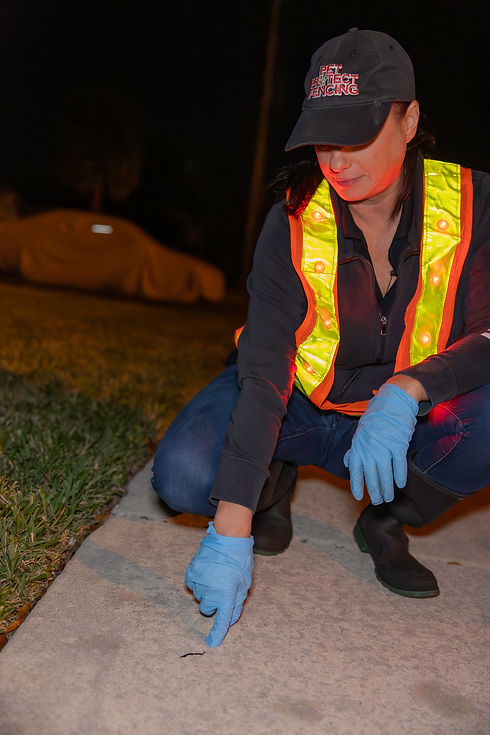Safe & Humane Toad Removal & Prevention | Serving SE & SW Florida in the USA and the Gold Coast of Australia
Thank you for visiting for more information on the New Guinea flatworm and Rat-Lungworm parasite and to document cases from your practice.


The New Guinea Flatworm (Platydemus manokwari), which is a carrier of the Nematode (Angiostrongylus cantonensis Rat-Lungworm parasite), is a flatworm species that is being found across the United States and Europe as well as other countries. New Guinea flatworms (NGF) have been rapidly reproducing undetected for many years along with other invasive flatworms that we’re now seeing here in the United States. NGFs are not only carriers of Rat-Lungworm, but they’re also infecting snails with the parasite and those snails are dangerous—and prevalent—carriers too. We are starting to see more and more cases of humans and animals being infected with the parasite carried by these worms, which causes non-specific symptoms such as fever, light sensitivity, muscle pain, fatigue, and insomnia. More specific symptoms may include constant headache, neck stiffness and pain, tingling or burning of the skin, double vision, bowel or bladder difficulties, and seizures. The most severe symptom of the Rat-Lungworm parasite is eosinophilic meningitis, which can cause death.
What is Rat-Lungworm Disease? A short video from the CDC
The Story of Rat-Lungworm Disease
Watch “The Accidental Host”, a 53-minute documentary about the silently spreading parasite.
"The threat it depicts—an illness which varies from confusing to catastrophic—is largely unknown to most physicians as well as travelers and residents at risk."


Potential Routes of Infection
Potential routes of infection of the human central nervous system (CNS) by the rat lungworm, Angiostrongylus cantonensis. Note that the normal life cycle involves (1) consumption of molluscs by rats, then (2) excretion of nematodes in rat feces, which are then (3) consumed by molluscs. Human infection can occur when uncooked infected molluscs are eaten (4a) or, more rarely, when uncooked contaminated paratenic (transport) hosts (4C) or vegetable matter (4b) is consumed. Adapted from Wang et al. (2008).
Source: https://entnemdept.ufl.edu/creatures/nematode/rat_lungworm.htm
Jeannine Tilford
Jeannine is a South Florida native who has worked for more than 25 years as an animal educator, invasive species specialist, and Florida Fish and Wildlife Conservation Commission (FWC)-registered Nuisance Wildlife Control Operator. Early in her career, Jeannine founded a 501c3 Agricultural Training Center; she went on to hold positions leading educational events at both Busch Wildlife Sanctuary and World of Wildlife. Jeannine enjoyed five years as a Veterinarian Technician, and has taught Biology, Environmental Science and Zoology to hundreds of students during her nine-year tenure as a science teacher. Her passion for conservation and animal welfare led her to launch Toad Busters in 2015. She’s since grown the company, which collects poisonous cane toads (Rhinella marina) from homeowners’ yards (to protect pets), into the leading authority on this non-native and invasive species. Jeannine has been featured in dozens of national publications including People, USA Today, Newsweek, Time, and others.

Jeannine Tilford and Dr. Brian Hicks have been researching and learning about many cases in which humans, pets and livestock have been affected by NGFW and the Rat-Lungworm parasite. They believe there are many more cases and deaths that have gone undiagnosed. Jeannine and Brian are in the process of creating a patented product to protect humans and pets from this parasite. There’s currently a need to educate more doctors and veterinarians about the symptoms and ways this parasite is being introduced and ingested.
Brian Hicks PhD
With a BA in Biology, a MS in Environmental Science, and a PhD in Oceanology/Marine Biology, Dr. Brian Hicks is a well-rounded and highly educated researcher, science educator, and conservationist. From having served as a Microbiologist and Biochemist for the United States Army at the Medical Research Institute of Infectious Diseases (USAMRIID), to a 42-year career as an instructor and Science Department Chair in the school system, Dr. Hicks has a proven track record of both logical and creative thinking and prioritizing the advancement of knowledge. Since 2017, his primary research interest has been developing chemical compound that will selectively eradicate the highly invasive, highly toxic, New Guinea Flatworm to protect people, pets, and critical natural & agricultural communities. He remains committed to finding an ecologically safe formula that does not harm people, pets or native plant and animal species but delivers a pesticide that will kill on contact and repel future infestations.








